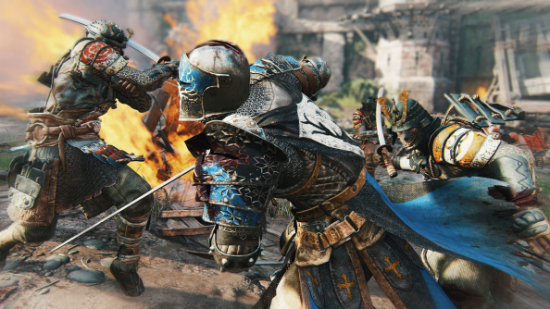A knight cleaves her way across a castle courtyard. She cuts an imposing figure – the swing of her sword mimicked by the swish of a sky-blue tabard. She is The Warden, and she bats away would-be opponents as if they were tennis balls fired from a machine.
Read more: the best League of Legends champions for beginners.
Then a worthy fighter steps over the drawbridge. Another knight, clad in thick armour. The two lock eyes, and the footsoldiers scatter. It’s to be a duel, between two highly capable adversaries. Well, passably capable. The Warden is controlled by me.
In my head, I hear the benevolent growl of For Honor creative director Jason VandenBerghe.
“The most important emotion of battle is the decision to not run,” he purrs. “That’s the hard bit. Everyone else fled, and you’re standing here. You’re the dumb one.”
The peasants fight among themselves and we circle each other. The other knight’s humanising features are encased in a steel helmet. But I’ve got to get to know him, and fast. When he lifts his sword above his head, that’s a tell – I do the same, just quickly enough to block a thrust that would’ve finished somewhere in my skull.
“It’s this incredibly aggressive empathy for your opponent,” says VandenBerghe. “You are trying to read your opponent’s mind, and at the same time trying to hide what you’re doing. It’s this psychic struggle.”
As I shift balance to strike from the left, then the right, then the left again, my opponent does the same, testing for weak spots. I feel the terror of tunnel vision, acutely aware that I could be attacked from behind at any time. Swordfighting, it turns out, is half-physical positioning, half-mental gymnastics – an act of constant evaluation.
This is not news to students of German Longsword, the rediscovered martial style first taught in the Holy Roman Empire. Now it’s taught in classes in Edinburgh and New York and Chicago, and 14 years ago VandenBerghe went to one.
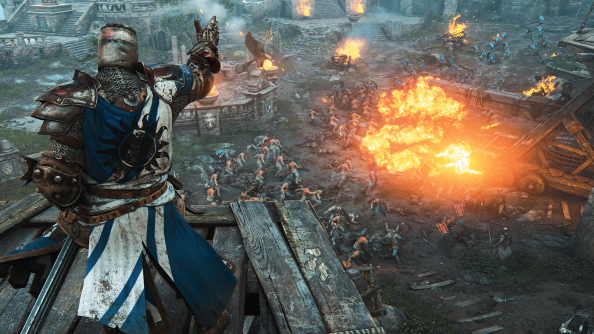
The designer, then working on Bond games at EA, was struck by the simplicity of the medieval system of battle stances. It was clear, it was exacting, it was powerful, and as he walked down the street afterwards the first iteration of For Honor’s control scheme clicked into place.
“Oh my God,” he thought. “If we took the principles and applied them to the right stick of a controller, it would feel the way I feel when I fight. The emotions would be the same, or close enough.”
VandenBerghe – who sports the kind of greying viking beard and unhinged grin that might adorn one of For Honor’s posters – began pitching the game to anyone who would listen. And for 10 years the answer was no… until at Ubisoft Montreal, somebody said yes. Now the game is nearly finished; an example of big-budget bravery to stand alongside the likes of Grow Up at Ubisoft’s E3 show.
Though everything about For Honor feels feudal, from the tabards to the combat system built on the shoulders of serfs, it has a story that leaps across time and continents – from the Knights’ Warden to the Vikings’ Raider and the Samurai’s Kensei. With three nameless protagonists and three very different settings, what ties that campaign together?
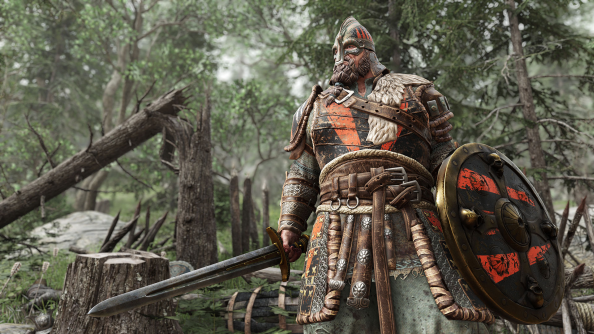
“One war,” answers VandenBerghe. “It’s all one chained conflict. The actions of the knight’s campaign create the events of the viking’s campaign and then that creates the events of the samurai’s campaign, one after the other.”
Each protagonist is a champion of their faction, but as much as possible Ubisoft want that champion to be you – male or female, an enigma attached to a title. The Warden, for instance, is merely a wandering knight who’s stumbled into a local struggle stirred up by Apollyon. She’s the personality of the piece – an apparent defender of the knights hiding a cruel agenda.
“Apoleon believes that humans are divided into wolves and sheep and we have a moral obligation to allow the wolves free reign,” VandenBerghe explains. “Anyone who is establishing laws or peace is actually being fundamentally dishonest about human nature. And so she’s set out to enact that view on the world itself. She’s got a bunch of believers around her, and you get all tangled up.”
This isn’t VandenBerghe’s first treatise on human nature. He worked on the story of Far Cry 3, Ubi Montreal’s divisive slice of colonial commentary. But For Honor’s storytelling is more reminiscent Prince of Persia: Sands of Time; the entire game is narrated, as if you’re being told the legend of yourself while playing.
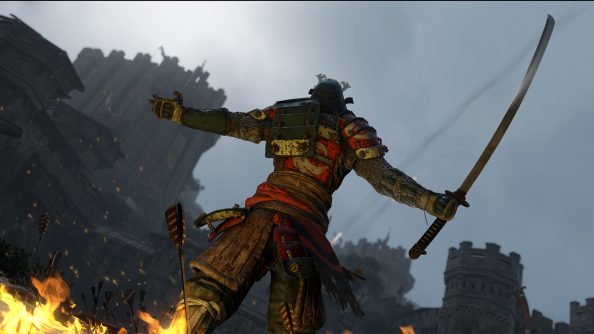
“The voice you’re hearing in the knight’s campaign is Holden Cross, the guy who knights you,” VandenBerghe divulges. “I love the structure, because we have a lot of opportunities to layer in meaning, foreshadowing and to express things that are going on.”
All of this melts away, of course, when the time comes to duel. Once you’ve dispatched the grunts and caught the eye of a meaty-looking enemy across the field, whether in the keep of a European castle or on the beaches of Japan.
“I would say actually that moment is the entire point of the game,” says VandenBerghe. “All these guys around you are fighting wildly, but here’s the one you really need to worry about. We wanted to put you in the middle and create the emotions of battle inside of you.
“Those emotions are universal throughout time,” he adds. “I think that’s what warriors go through on the battlefield, and that it’s true in some way. When you play the game you go, ‘I know what this is, this makes sense to me’. I think it would make sense to warriors a thousand years ago.”
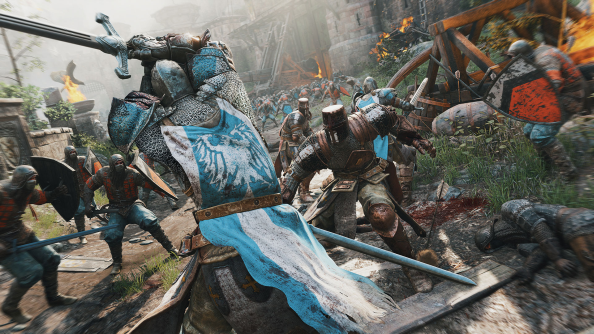
Back in the courtyard I find that final weak spot, sinking my sword into my opponent’s collar bone. An animation sequence pulls it out again, and reinserts it horizontally through his neck. The knight crumples, and our brief but bloody love affair is over.
In a world reshaped by Dark Souls and League of Legends, For Honor’s intricate combat and minion-flooded multiplayer does make sense to me. Somewhere between hack ‘n’ slash frivolity and the pedantic simulation of Die by the Sword, VandenBerghe and team might have found not just the right feel for combat, but the feels too.
